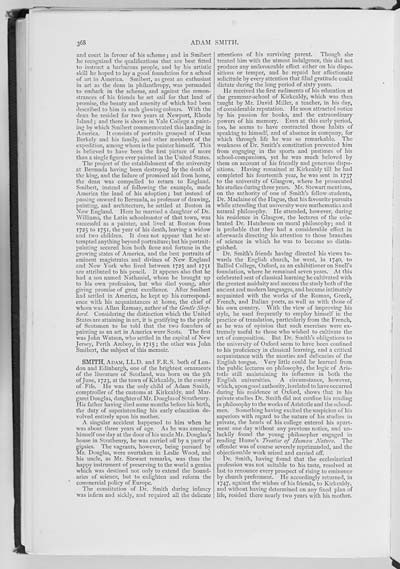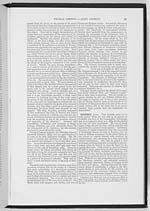368
and court in favour of his scheme; and in Smibert
he recognized the qualifications that are best fitted
to instruct a barbarous people, and by his artistic
skill he hoped to lay a good foundation for a school
of art in America. Smibert, as great an enthusiast
in art as the dean in philanthropy, was persuaded
to embark in the scheme, and against the remon-
strances of his friends he set sail for that land of
promise, the beauty and amenity of which had been
described to him in such glowing colours. With the
dean he resided for two years at Newport, Rhode
Island; and there is shown in Yale College a paint-
ing by which Smibert commemorated this landing in
America. It consists of portraits grouped of Dean
Berkely and his family, and other members of the
expedition, among whom is the painter himself. This
is believed to have been the first picture of more
than a single figure ever painted in the United States.
The project of the establishment of the university
at Bermuda having been destroyed by the death of
the king, and the failure of promised aid from home,
the dean was compelled to return to England.
Smibert, instead of following the example, made
America the land of his adoption; but instead of
passing onward to Bermuda, as professor of drawing,
painting, and architecture, he settled at Boston in
New England. Here he married a daughter of Dr.
Williams, the Latin schoolmaster of that town, was
successful as a painter, and lived at Boston from
1725 to 1751, the year of his death, leaving a widow
and two children. It does not appear that he at-
tempted anything beyond portraiture; but his portrait-
painting secured him both fame and fortune in the
growing states of America, and the best portraits of
eminent magistrates and divines of New England
and New York who lived between 1725 and 1751
are attributed to his pencil. It appears also that he
had a son named Nathaniel, whom he brought up
to his own profession, but who died young, after
giving promise of great excellence. After Smibert
had settled in America, he kept up his correspond-
ence with his acquaintances at home, the chief of
whom was Allan Ramsay, author of the Gentle Shep-
herd. Considering the distinction which the United
States are attaining in art, it is gratifying to the pride
of Scotsmen to be told that the two founders of
painting as an art in America were Scots. The first
was John Watson, who settled in the capital of New
Jersey, Perth Amboy, in 1715; the other was John
Smibert, the subject of this memoir.
SMITH, ADAM, LL.D. and F.R.S. both of Lon-
don and Edinburgh, one of the brightest ornaments
of the literature of Scotland, was born on the 5th
of June, 1723, at the town of Kirkcaldy, in the county
of Fife. He was the only child of Adam Smith,
comptroller of the customs at Kirkcaldy, and Mar-
garet Douglas, daughter of Mr. Douglas of Strathenry.
His father having died some months before his birth,
the duty of superintending his early education de-
volved entirely upon his mother.
A singular accident happened to him when he
was about three years of age. As he was amusing
himself one day at the door of his uncle Mr. Douglas's
house in Strathenry, he was carried off by a party of
gipsies. The vagrants, however, being pursued by
Mr. Douglas, were overtaken in Leslie Wood, and
his uncle, as Mr. Stewart remarks, was thus the
happy instrument of preserving to the world a genius
which was destined not only to extend the bound-
aries of science, but to enlighten and reform the
commercial policy of Europe.
The constitution of Dr. Smith during infancy
was infirm and sickly, and required all the delicate
attentions of his surviving parent. Though she
treated him with the utmost indulgence, this did not
produce any unfavourable effect either on his dispo-
sitions or temper, and he repaid her affectionate
solicitude by every attention that filial gratitude could
dictate during the long period of sixty years.
He received the first rudiments of his education at
the grammar-school of Kirkcaldy, which was then
taught by Mr. David Miller, a teacher, in his day,
of considerable reputation. He soon attracted notice
by his passion for books, and the extraordinary
powers of his memory. Even at this early period,
too, he seems to have contracted those habits of
speaking to himself, and of absence in company, for
which through life he was so remarkable. The
weakness of Dr. Smith's constitution prevented him
from engaging in the sports and pastimes of his
school-companions, yet he was much beloved by
them on account of his friendly and generous dispo-
sitions. Having remained at Kirkcaldy till he had
completed his fourteenth year, he was sent in 1737
to the university of Glasgow, where he prosecuted
his studies during three years. Mr. Stewart mentions,
on the authority of one of Smith's fellow-students,
Dr. Maclaine of the Hague, that his favourite pursuits
while attending that university were mathematics and
natural philosophy. He attended, however, during
his residence in Glasgow, the lectures of the cele-
brated Dr. Hutcheson on moral philosophy; and it
is probable that they had a considerable effect in
afterwards directing his attention to those branches
of science in which he was to become so distin-
guished.
Dr. Smith's friends having directed his views to-
wards the English church, he went, in 1740, to
Balliol College, Oxford, as an exhibitioner on Snell's
foundation, where he remained seven years. At this
celebrated seat of classical learning he cultivated with
the greatest assiduity and success the study both of the
ancient and modern languages, and became intimately
acquainted with the works of the Roman, Greek,
French, and Italian poets, as well as with those of
his own country. With the view of improving his
style, he used frequently to employ himself in the
practice of translation, particularly from the French,
as he was of opinion that such exercises were ex-
tremely useful to those who wished to cultivate the
art of composition. But Dr. Smith's obligations to
the university of Oxford seem to have been confined
to his proficiency in classical learning, and a critical
acquaintance with the niceties and delicacies of the
English tongue. Very little could be learned from
the public lectures on philosophy, the logic of Aris-
totle still maintaining its influence in both the
English universities. A circumstance, however,
which, upon good authority, is related to have occurred
during his residence at Oxford, shows that in his
private studies Dr. Smith did not confine his reading
in philosophy to the works of Aristotle and the school-
men. Something having excited the suspicion of his
superiors with regard to the nature of his studies in
private, the heads of his college entered his apart-
ment one day without any previous notice, and un-
luckily found the young philosopher engaged in
reading Hume's Treatise of Human Nature. The
offender was of course severely reprimanded, and the
objectionable work seized and carried off.
Dr. Smith, having found that the ecclesiastical
profession was not suitable to his taste, resolved at
last to renounce every prospect of rising to eminence
by church preferment. He accordingly returned, in
1747, against the wishes of his friends, to Kirkcaldy,
and without having determined on any fixed plan of
life, resided there nearly two years with his mother.

![]() Universal Viewer |
Universal Viewer | ![]() Mirador |
Large image | Transcription
Mirador |
Large image | Transcription
![]()
